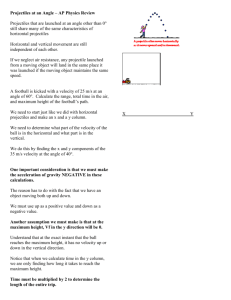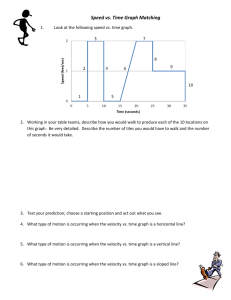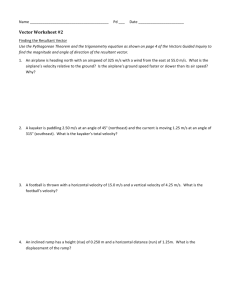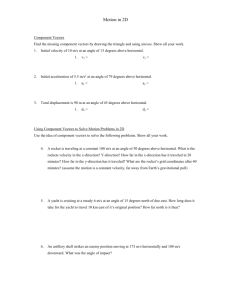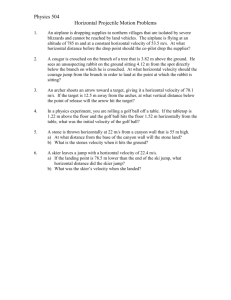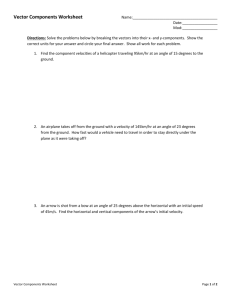Projectiles projection at an angle
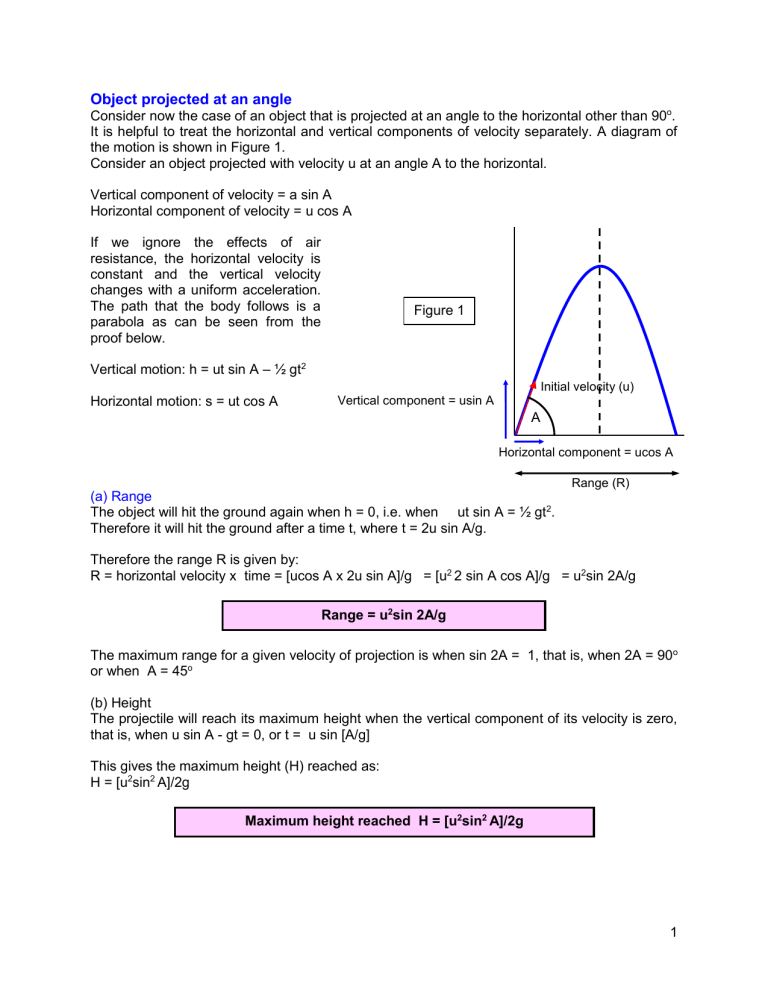
Object projected at an angle
Consider now the case of an object that is projected at an angle to the horizontal other than 90 o .
It is helpful to treat the horizontal and vertical components of velocity separately. A diagram of the motion is shown in Figure 1.
Consider an object projected with velocity u at an angle A to the horizontal.
Vertical component of velocity = a sin A
Horizontal component of velocity = u cos A
If we ignore the effects of air resistance, the horizontal velocity is constant and the vertical velocity changes with a uniform acceleration.
The path that the body follows is a parabola as can be seen from the proof below.
Vertical motion: h = ut sin A – ½ gt 2
Figure 1
Horizontal motion: s = ut cos A Vertical component = usin A
A
Initial velocity (u)
Horizontal component = ucos A
(a) Range
The object will hit the gro und again when h = 0, i.e. when ut sin A = ½ gt 2 .
Range (R)
Therefore it will hit the ground after a time t, where t = 2u sin A/g.
Therefore the range R is given by:
R = horizontal velocity x time = [ucos A x 2u sin A]/g = [u 2 2 sin A cos A]/g = u 2 sin 2A/g
Range = u 2 sin 2A/g
The maximum range for a given velocity of projection is when sin 2A = 1, that is, when 2A = 90 o or when A = 45 o
(b) Height
The projectile will reach its maximum height when the vertical component of its velocity is zero, that is, when u sin A - gt = 0, or t = u sin [A/g]
This gives the maximum height (H) reached as:
H = [u 2 sin 2 A]/2g
Maximum height reached H = [u 2 sin 2 A]/2g
1
Example problem
A stone is projected at an angle of 60 o to the horizontal with a velocity of 30 m s -1 . Calculate (a) the highest point reached, (b) the range, (c) the time taken for the flight, (d) the height of the stone at the instant that the path makes an angle of 30 o with the horizontal.
(a) Highest point = 30 2 sin 2 600/2g = 900 x 0.75/20 = 33.75m.
(b)Range = 30 2 sin 120 o /10 = 900x0.866/10 = 78 m.
(c)Timeof flight = 2x30sin60 o /10 = 5.2 s
( d) At the point when the path makes an angle of 30 o to the horizontal we have: tan 30 o = vertical component of velocity/ horizontal component of velocity
= vertical component/30 cos60
The vertical component (v) is given by the formula. v 2 =30 2 sin 2 60 o - (2x10xh)=(900x 0.75)-20h where h is the height reached at that point.
Therefore tan 30 o = [675 - 20h]/15 15 x 0.58 = 675 – 20h 8.66 = 675 - 20h
20h = 666.3 h = 33.3 m
Example problem
An aeroplane flies at a height h at a constant speed u in a straight horizontal line, so as to pass vertically over a certain gun. At the instant when the aeroplane is directly over it the gun fires a shell which hits the plane (Figure 7.11). Find the minimum muzzle velocity (v) of the shell and the correct angle of elevation (A) of the gun at this velocity (neglecting air resistance).
If we require the minimum muzzle velocity, then the height of the plane when it is hit must be the maximum height reached by the shell, in other words the vertical component of its velocity must be zero when it hits the plane
Therefore 0 = v 2 sin 2 A –2gh Therefore: 0 = v 2 (1 - cos 2 A) - 2gh
But u = vcos A v 2 = u 2 +2gh v =√ (u 2 + 2gh) and this gives tanA = [√2gh]/u h
2
Trajectory – parabolic path
The shape of the trajectory can be found by combining the equations for vertical and horizontal velocity.
Taking the vertical displacement as y and the horizontal displacement as x, we have. x = ut cos A y = ut sin A – ½ gt 2
This gives: y = x tanA – gx 2 /2u 2 cos 2 A
For a given angle of projection (A) and projection velocity (u), this becomes: y = Bx - Cx 2 where B and C are constants (B = tanA and C = g/2u 2 cos 2 A) ; this is the equation of a parabola.
The above equations only refer to projectiles where the effects of air resistance have been ignored. Quite different paths may be found in practice for such objects as golf balls, javelins and discoi.
Student investigation
Make three model car tracks, one straight and two in the shape of a catenary. Try allowing model cars to run down each track and explain what you observe.
Start two cars at different points on the two catenary tracks. Which one gets to the bottom first? Try to explain the results.
3

